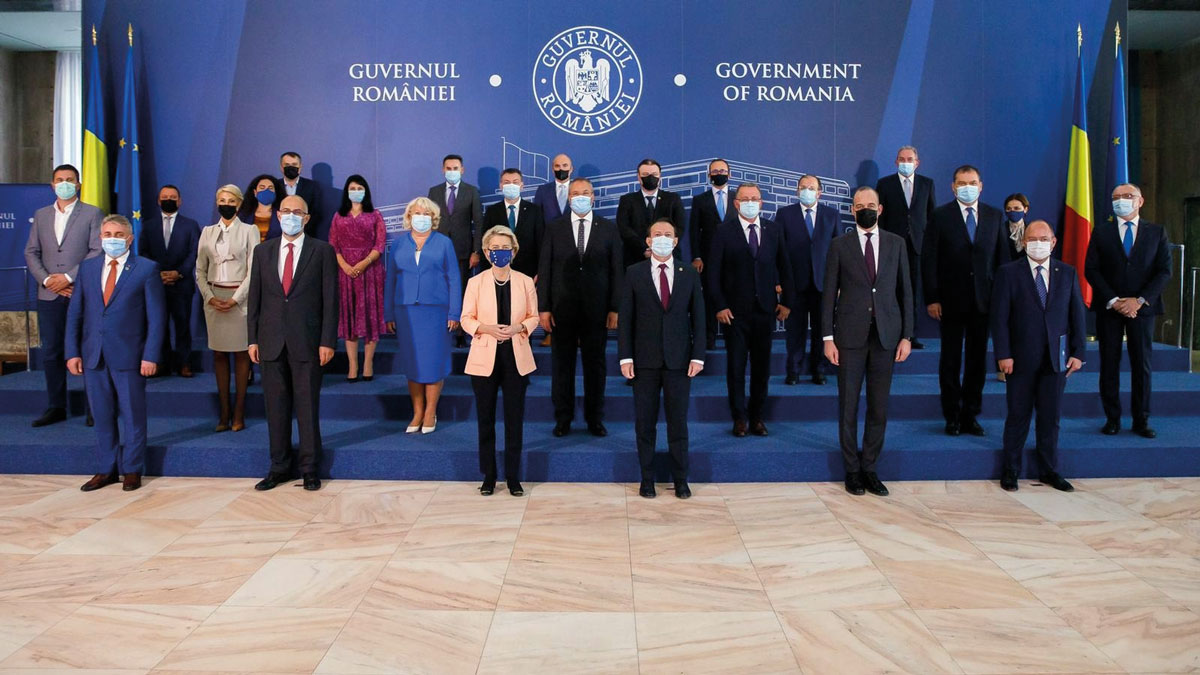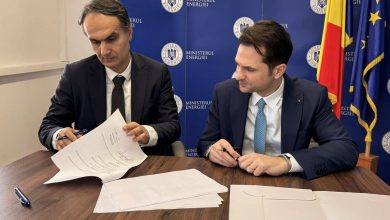European Commission Endorses Romania’s EUR 29.2bln Recovery and Resilience Plan
The European Commission (EC) has adopted a positive assessment of Romania’s recovery and resilience plan, an important step towards the EU disbursing EUR 14.2 billion in grants and EUR 14.9 billion in loans to Romania under the Recovery and Resilience Facility (RRF). This financing will support the implementation of the crucial investment and reform measures outlined in Romania’s recovery and resilience plan. It will play a crucial role in enabling Romania to emerge stronger from the COVID-19 pandemic.
The RRF is the key instrument at the heart of NextGenerationEU. It will provide up to EUR 800 billion (in current prices) to support investments and reforms across the EU. The Romanian plan forms part of an unprecedented, coordinated EU response to the COVID-19 crisis, to address common European challenges by embracing the green and digital transitions, to strengthen economic and social resilience and the cohesion of the Single Market.
The Commission assessed Romania’s plan based on the criteria set out in the RRF Regulation. The Commission’s analysis considered, in particular, whether the investments and reforms contained in Romania’s plan support the green and digital transitions; contribute to effectively addressing challenges identified in the European Semester; and strengthen its growth potential, job creation and economic and social resilience.
Securing Romania’s green and digital transitions
The Commission’s assessment finds that Romania’s plan devotes 41% of the plan’s total allocation on measures that support the green transition. The plan includes measures to phase out coal and lignite power production by 2032. Reforms promoting sustainable transport include the decarbonisation of road transport, green taxation, incentives for zero-emission vehicles, and a modal shift to railways and water transport. The plan also has a strong focus on improving the energy efficiency of private and public buildings.
The Commission’s assessment of Romania’s plan finds that it devotes 21% of its total allocation on measures that support the digital transition. This includes measures to digitalise the public administration and businesses, improve connectivity, cybersecurity and digital skills and develop an integrated e-Health and telemedicine system. Measures to support the digitalisation of education are expected to contribute to skills development for both students and teachers and will be reinforced by measures to modernise school laboratories and creating smart labs. Participation in a multi-country project is planned to be implemented as an Important Project of Common European Interest (IPCEI) on microelectronics.
Reinforcing Romania’s economic and social resilience
The Commission considers that Romania’s plan includes an extensive set of mutually reinforcing reforms and investments that contribute to effectively addressing all or a significant subset of the economic and social challenges outlined in the country-specific recommendations addressed to Romania.
The implementation of social and educational reforms and investments is expected to tackle long-standing vulnerabilities and structural deficiencies. The plan provides for measures to strengthen the public administration, including through reinforcing the effectiveness of the judicial system and fighting corruption. It will also include measures to support private investment, particularly for SMEs, and improve the business environment through reducing the administrative burden for firms. The plan’s reforms in the areas of education and jobs are expected to support a stronger labour market, favouring growth. The flagship reforms on the coal phase-out and the decarbonisation of transport, and investments promoting the green and digital transition are expected to boost competitiveness and make the economy overall more sustainable. Social resilience should improve as a result of the educational reforms and investments included in the plan. Having a well-skilled labour force and reducing early school leaving should make the economy more resilient against future shocks and the population more adaptable to changing economic patterns.
Supporting flagship investment and reform projects
Romania’s plan proposes projects in each of the seven EU flagship areas. These are specific investment projects which address issues that are common to all Member States in areas that create jobs and growth and are needed for the green and digital transition. For instance, the Romanian plan includes a project to build a secure government cloud computing infrastructure to allow for the interoperability of public administration platforms and data services, fostering the adoption of digital public services for citizens and companies, and the deployment of electronic identity cards for 8.5 million citizens.
The assessment also finds that none of the measures included in the plan significantly harm the environment, in line with the requirements laid out in the RRF Regulation.
The control systems put in place by Romania are considered adequate to protect the financial interests of the Union. The plan provides sufficient details on how national authorities will prevent, detect, and correct instances of conflict of interest, corruption and fraud relating to the use of funds.
“I am delighted to present the European Commission’s endorsement of Romania’s EUR 29.2 billion recovery and resilience plan. By focusing on measures to secure the green and digital transitions, from improving the energy efficiency of buildings to improving connectivity and digital skills, the measures set out in the plan have the potential to be truly transformative. We will stand with you in the years to come to ensure that the ambitious investments and reforms set out in the plan are fully implemented,” President Ursula von der Leyen said.
“Today, we have endorsed Romania’s recovery plan to emerge stronger after the crisis and boost economic growth. The plan will help Romania to decarbonise, with measures to phase out coal and lignite power production that should boost competitiveness and make the economy more sustainable. It will also promote sustainable transport and improve the energy efficiency of public and private buildings. We welcome its focus on improving connectivity and cybersecurity as well as digitalising public administration, healthcare, and education, thereby improving digital skills development. By carrying out social and educational reforms, backed by investments, Romania should stimulate growth by tackling some long-standing structural issues – with a stronger business environment and less red tape,” Valdis Dombrovskis, Executive Vice-President for an Economy that Works for People, mentioned.
“With today’s green light from the Commission for Romania’s recovery and resilience plan, the country takes an important step towards a more prosperous, competitive and sustainable future. This is a big plan, both in terms of the amount of funding Romania is set to receive and the ambitious nature of its reforms and investments. The European Commission will support the Romanian authorities in their efforts to deliver on these commitments, which if successfully implemented will bring tremendous benefits to Romania’s citizens and businesses,” Paolo Gentiloni, Commissioner for Economy, added.
How did EC assess Romania’s recovery and resilience plan?
The Commission is assessing the recovery and resilience plans based on eleven criteria set out in the Recovery and Resilience Facility (RRF) Regulation. The 11 criteria require an assessment of whether:
- the measures have a lasting impact;
- the measures address the challenges identified in the country-specific recommendations or a significant subset of them;
- the milestones and targets which allow for monitoring the progress with the reforms and investments are clear and realistic;
- the plans meet the 37% climate expenditure target and the 20% digital expenditure target;
- the plans respect the do no significant harm principle;
- the plans provide an adequate control and audit mechanism and set out the plausibility of the costing information.
The Commission has summarised its assessment in the proposal for the Council Implementing Decision. The accompanying staff-working document provides detailed documentation on the assessment.
Does Romania’s recovery and resilience plan effectively support the green transition?
The Romanian plan’s contribution to the green transition amounts to 41% of its total allocation of EUR 29.2 billion. This exceeds the minimum of 37% required by the RRF Regulation.
The plan has a strong focus on the green transition, with flagship reforms on the phasing-out of coal and the decarbonisation of road transport. The reforms and investments are expected to significantly decarbonise the energy sector and unlock the potential for renewables deployment. The strong focus on energy efficiency of private and public buildings, digitalisation of road and rail transport and the deployment of electric charging infrastructures, climate change adaptation and circular economy, will also facilitate the green transition in all sectors of the economy.
With several reforms and investments in the forestry sector, such as the adoption of the National Forest Strategy and the ecological reconstruction of habitats and the conservation of species, the Plan is also expected to contribute to biodiversity conservation and restoration.
Does Romania’s recovery and resilience plan effectively contribute to the digital transition?
The Romanian plan’s contribution to the digital transition amounts to 21% of its total allocation of EUR 29.2 billion. This exceeds the minimum of 20% required by the RRF Regulation.
The plan is expected to address digitalisation challenges related to the public administration by proposing a comprehensive package of measures to provide secure, interoperable, cost-efficient, and fast user-centric services for citizens and businesses. The deployment of the electronic identity card is expected to facilitate the digital interaction between public/private entities and citizens.
The business sector is expected to benefit from significant investments which are expected to accelerate the digitalisation of both SMEs and large companies with a focus on the development and adoption of advanced technologies. The plan includes a reform to streamline, simplify and fully digitalise business-related regulatory requirements. In addition, participation in a multi-country project is planned to be implemented as an Important Project of Common European Interest (IPCEI) on microelectronics.
As regards education, reforms include standards for ensuring the quality of online educational activities and the alignment of the educational system to DigComp, the European framework for digital competences for students. Investments will support the development of training courses for digital literacy, grants for informatics laboratories and smart hubs, the development of open educational resources and schemes for the digitalisation of universities.
Does the recovery and resilience plan represent a balanced response to the economic and social situation of Romania?
The Romanian plan represents a comprehensive and adequately balanced response to Romania’s economic and social situation, thereby contributing appropriately to all six pillars referred to in the RRF Regulation.
The plan follows a holistic approach to achieve recovery and increase potential growth, while enhancing socio-economic and institutional resilience. The plan contains mutually reinforcing and coherent reforms and investments that refer to policy areas of EU relevance structured around the six pillars.
The plan contains a series of measures that are expected to directly or indirectly support private investments, including for SMEs, increase the capacity of the country to attract investment and create new businesses and jobs. The plan also aims to reinforce fiscal sustainability through important reforms of the tax administration, the tax framework, the management of public expenditure and the pension system. The plan also envisages strengthening social and territorial cohesion through structural measures on the labour market and important reforms and investments targeting both urban and rural development, which are expected to reduce territorial disparities at regional, intra-regional and intra-county level.
The proposed reforms and investments are expected to strengthen the overall resilience of the health system, including through its digitalisation. Finally, measures in the plan aim to help the next generations mainly by addressing challenges in terms of quality, equity, and infrastructure in the educational system. The upgrade of school and university infrastructure in urban and rural areas, the digitalisation of education and a system of grants to reduce the drop-out rate are the main measures to address these challenges.
Do the reforms presented by Romania effectively address a significant part of the country-specific recommendations issued to it in the context of the European Semester?
The Romanian plan includes an extensive set of mutually reinforcing reforms and investments that contribute to effectively addressing a significant subset of the economic and social challenges outlined in the country-specific recommendations addressed to Romania. Notably, reforms and investments included in the plan are expected to contribute to the areas of sustainability of public finances and the pension system, healthcare, public administration, business environment, education, and green and digital transition.
The full digitalisation of the tax administration and gradual phase out of excessive tax incentives, as well as an improved fiscal framework, will contribute to the sustainability of public finances. The plan also aims at ensuring the sustainability and fairness of the public pension system. Healthcare reforms, accompanied by digitalisation investments, are expected to improve the access to and the cost-efficiency and resilience of the healthcare system.
Evidence-based decision making, long-term planning and public consultations, and measures aimed at improving the public procurement process, reinforcing the effectiveness of the judicial system, and fighting corruption will contribute to improving the quality and effectiveness of the public administration. Reforms on minimum wage setting, on strengthening the corporate governance of state-owned enterprises and on social dialogue also address long-standing country-specific recommendations. The plan also introduces a unitary, inclusive, and quality early-childhood education and care system accompanied by investments in childcare.
Next steps
The Council will have, as a rule, four weeks to adopt the Commission’s proposal.
The Council’s approval of the plan would allow for the disbursement of EUR 3.6 billion to Romania in pre-financing. This represents 13% of the total allocated amount for Romania.
The Commission will authorise further disbursements based on the satisfactory fulfilment of the milestones and targets outlined in the recovery and resilience plan, reflecting progress on the implementation of the investments and reforms.








